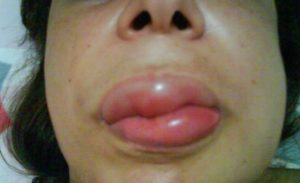ANGIOEDEMA WITHOUT URTICARIA -What are the types?
Hereditary Angioedema
This is a rare genetic disease caused by changes on a protein called C1 inhibitor (C1-INH), which can be inherited or caused by a mutation.
This condition is particularly characterized by the recurrent onset of large skin bumps throughout life. This kind of angioedema commonly affects the face, hands, feet, genitalia, larynx, and guts.
Those bumps are cosmetically troublesome because they cause deformities and are usually painful. When involving guts, they can cause abdominal pain, diarrhea, or vomiting. The biggest problem is when it affects the larynx – a part of respiratory tract – because it may lead to suffocation or even death if not promptly treated.
Hereditary angioedema flares occur spontaneously or as a result of infections, surgeries, trauma, stress, menses.

Acquired Angioedema
This is a very rare type of angioedema without urticaria that occurs as a result of a deficiency of a protein named C1 inhibitor (C1-INH),which may develop in individuals with lymphoproliferative syndromes (such as lymphomas) or autoimmune diseases.
Symptoms are similar to those of hereditary angioedema.
Angioedema caused by angiotensin converting enzyme inhibitor (ACEi)
ACEi stands for angiotensin converting enzyme inhibitor, which is a group of drugs commonly used for high blood pressure and heart failure management. These are drugs whose names end with “pril”, such as, for example, captopril, enalapril, fosinopril, lisinopril, and quinapril.
Up to 3% of the patients taking these drugs may experience repeated angioedema episodes because of increased levels of bradykinin. Those episodes may develop right after the start, after months, or even after years of therapy. This makes diagnosis difficult. In this kind of angioedema, no change is seen on C1 inhibitor.
It predominantly affects the face, lips and tongue, and may lead to suffocation due to upper airways closure. Swelling is very intense and long-lasting.
References:
Allergy 2014 May;69(5):602-16
Int J Emerg Med. 2012 Nov 6;5(1):39
J Am Acad Dermatol. 2011 Oct;65(4):843-50
Clin Rev Allergy Immunol. 2016 Oct;51(2):183-92






